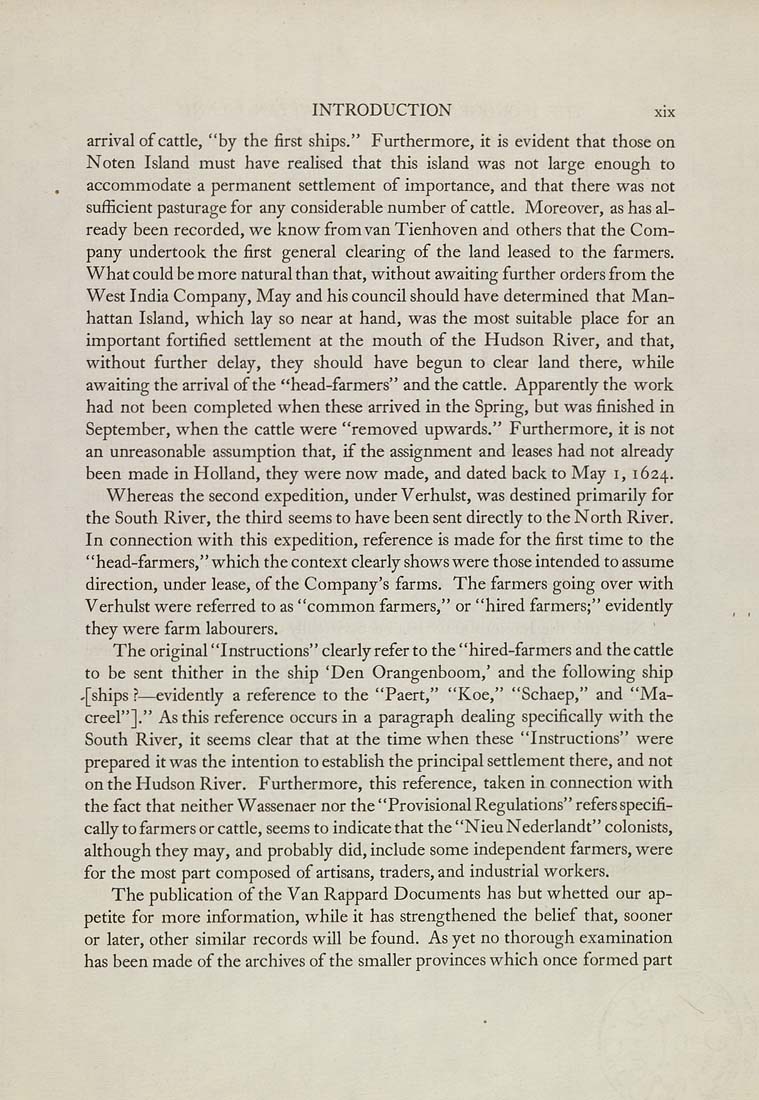INTRODUCTION xix
arrival of cattle, "by the first ships." Furthermore, it is evident that those on
Noten Island must have realised that this island was not large enough to
accommodate a permanent settlement of Importance, and that there was not
sufficient pasturage for any considerable number of cattle. Moreover, as has al¬
ready been recorded, we know from van Tienhoven and others that the Com¬
pany undertook the first general clearing of the land leased to the farmers.
What could be more natural than that, without awaiting further orders from the
West India Company, May and his council should have determined that Man¬
hattan Island, which lay so near at hand, was the most suitable place for an
important fortified settlement at the mouth of the Hudson River, and that,
without further delay, they should have begun to clear land there, while
awaiting the arrival of the "head-farmers" and the cattle. Apparently the work
had not been completed when these arrived in the Spring, but was finished in
September, when the cattle were "removed upwards." Furthermore, it is not
an unreasonable assumption that, if the assignment and leases had not already
been made in Holland, they were now made, and dated back to May i, 1624.
Whereas the second expedition, under Verhulst, was destined primarily for
the South River, the third seems to have been sent directly to the North River.
In connection with this expedition, reference Is made for the first time to the
"head-farmers," which the context clearly shows were those intended to assume
direction, under lease, of the Company's farms. The farmers going over with
Verhulst were referred to as "common farmers," or "hired farmers;" evidently
they were farm labourers.
The original''Instructions" clearly refer to the "hired-farmers and the cattle
to be sent thither in the ship 'Den Orangenboom,' and the following ship
-[ships ?—evidently a reference to the "Paert," "Koe," "Schaep," and "Ma¬
creel"]." As this reference occurs in a paragraph deahng specifically with the
South River, It seems clear that at the time when these "Instructions" were
prepared it was the intention to establish the principal settlement there, and not
on the Hudson River. Furthermore, this reference, taken in connection with
the fact that neither Wassenaer nor the "Provisional Regulations" refers specifi¬
cally to farmers or cattle, seems to indicate that the "Nieu Nederlandt" colonists,
although they may, and probably did, include some independent farmers, were
for the most part composed of artisans, traders, and industrial workers.
The publication of the Van Rappard Documents has but whetted our ap¬
petite for more information, while it has strengthened the belief that, sooner
or later, other similar records will be found. As yet no thorough examination
has been made of the archives of the smaller provinces which once formed part
|








